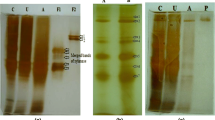Abstract
A good proportion ofStreptomyces isolates from natural sources produced extracellular xylan hydrolase. Nineteen isolated showing high activity were able to completely or partially degrade wheat bran in the growth medium. Chromatographic analysis of commercial xylan degradation products suggested that the isolates produced either endo-or exo-xylan hydrolases or their mixtures. Mixed additions of culture fluids showed a highly synergistic effect, up to an increase by 200 %. In a few cases antagonism was seen which, however, could be removed by dialysis of the culture fluid.
Similar content being viewed by others
References
Dekker R. F. H., Richards G. N.: Hemicellulases. InAdvances in Carbohydrate Chemistry and Biochemistry. Ed. Tipson S. R., Horton D., Acad. Press N.Y.32, 278 (1976).
Inone M., Okada S., Fukumoto J.: Juice clarifying enzyme: II Purification of accelerating factor for juice clarification and some properties of the purified preparation.Nippon Nogei Kogaku Kaishi 44, 1 (1970a).
Inone M., Okada S., Fukumoto J.: Juice clarifying enzymes: III Accelerating effect of the hemicellulase on the clarification of suspension of insoluble particles from orange juice.Nippon Nogei Kogaku Kaishi 44, 8 (1970b). Cited in Biological Abstracts51, 88410 (1970).
Lowry O. H., Rosebrough N. J., Farr A. L., Randall R. J.: Protein measurement with the folin phenol reagent.J. Biol. Chem. 193, 265 (1951).
Monteboro G., Bertuccioli M.: Trials on the use of different enzyme preparations in red wine making.Lebensm. Win. Technol. 9, 225 (1976).
Miller G. L.: Use of dinitrosalicylic acid reagent for determination of reducing sugar.Anal. Chem. 31, 426(1959).
Thaysen A. C., Bunker H. J.: The Microbiology of Cellulose, Hemicelluloses, Pectin and Gums. Oxford Univ. Press, London, pp. 3–15 (1927).
Trevelyan W. E., Procter D. P., Harrison J. S.: Detection of sugars on paper chromatograms.Nature 166, 444 (1950).
Whistler R. L., Richards E. L.: Hemicelluloses. InThe Carbohydrates; Chemistry and Biochemistry, 2nd ed. Ed. Pigman W., Horton D. Acad. Press, N.Y.114, 447 (1970).
Author information
Authors and Affiliations
Rights and permissions
About this article
Cite this article
Sreenath, H.K., Joseph, R. & Murthy, V.S. Studies on xylan hydrolases from different strains ofStreptomyces and their mutual influences in the breakdown of xylan. Folia Microbiol 23, 299–303 (1978). https://doi.org/10.1007/BF02876684
Received:
Issue Date:
DOI: https://doi.org/10.1007/BF02876684




